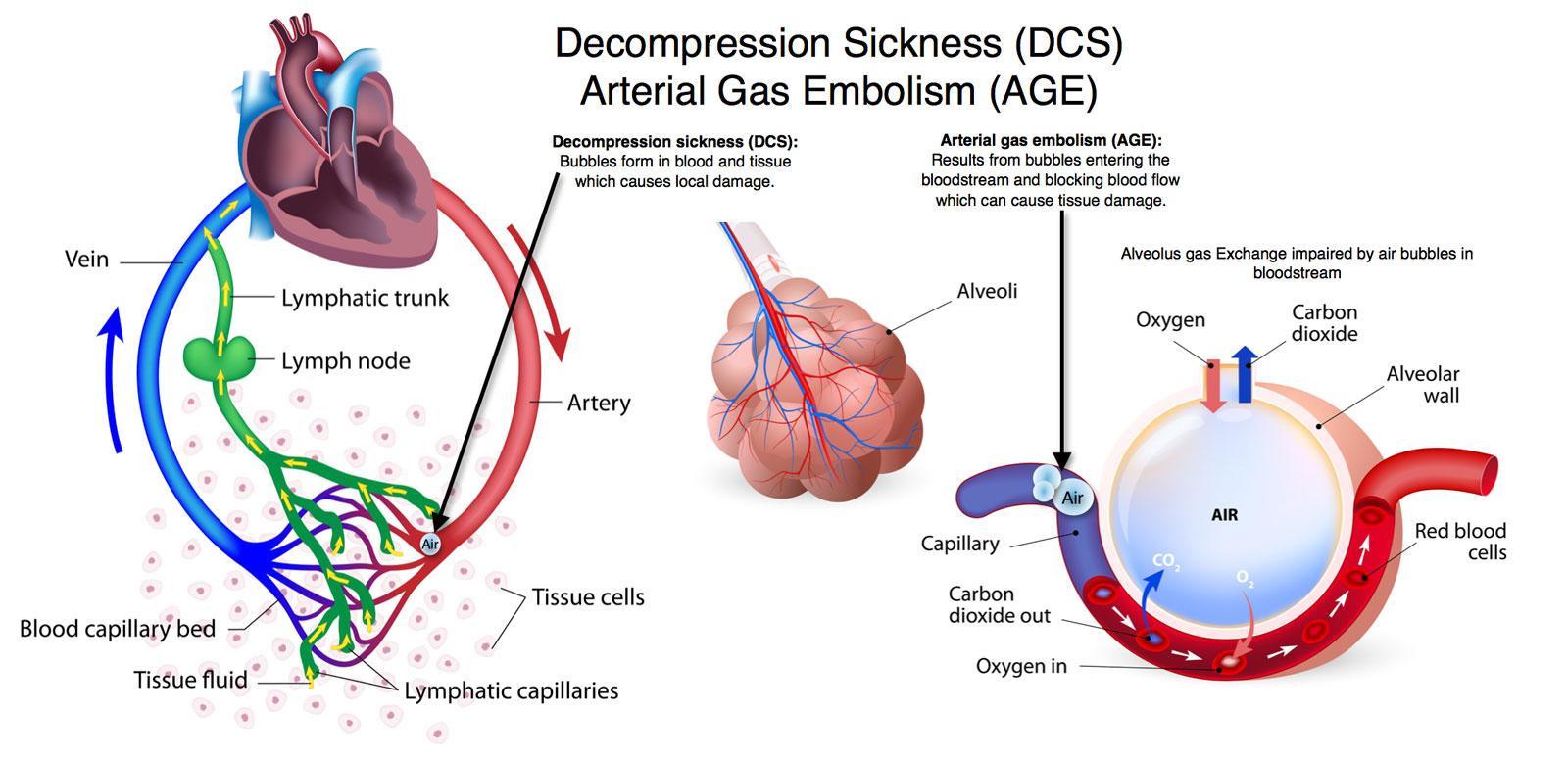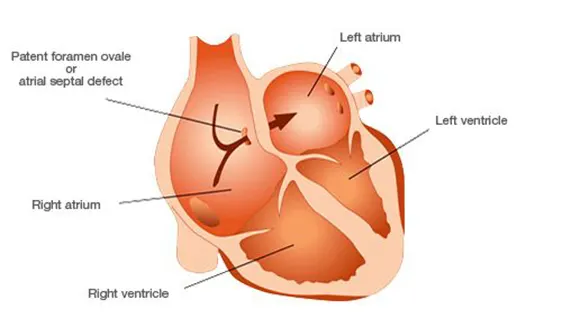Assessment of PFO as Related to DCS in the Spaceflight Environment and During Ground Testing

In June 2024, the NASA Office of the Chief Health and Medical Officer (OCHMO) Standards Team hosted an independent assessment working group to review the status and progress of research and clinical activities intended to mitigate the risk of decompression sickness (DCS) related to patent foramen ovale (PFO) during spaceflight and associated ground testing and human subject studies.
Decompression sickness (DCS) is a condition which results from dissolved gases (primarily nitrogen) forming bubbles in the bloodstream and tissues. It is usually experienced in conditions where there are rapid decreases in ambient pressure, such as in scuba divers, high-altitude aviation, or other pressurized environments. The evolved gas bubbles have various physiological effects and can obstruct the blood vessels, trigger inflammation, and damage tissue, resulting in symptoms of DCS. NASA presently classifies DCS into two categories: Type I DCS, which is less severe, typically leads to musculoskeletal symptoms including pain in the joints or muscles, or skin rash. Type II DCS is more severe and commonly results in neurological, inner ear, and cardiopulmonary symptoms. The risk of DCS in spaceflight presents during extravehicular activities (EVAs) in which astronauts perform mission tasks outside the spaceflight vehicle while wearing a pressurized suit at a lower pressure than the cabin pressure. DCS mitigation protocols based on strategies to reduce systemic nitrogen load are implemented through the combination of habitat environmental parameters, EVA suit pressure, and breathing gas procedures (prebreathe protocols) to achieve safe and effective mission operations. The pathophysiology of DCS has still not been fully elucidated since cases occur despite the absence of detected gas bubbles but includes right to left shunting of venous gas emboli (VGE) via several potential mechanisms, one of which is a Patent Foramen Ovale (PFO).

Decompression sickness (DCS): Bubbles form in blood and tissue which causes local damage.
Arterial gas embolism (AGE): Results from bubbles entering the bloodstream and blocking blood flow which can cause tissue damage.
Peter N. Schochet, MD and Hauw S. Lie, MD
From: Dr. Schochet & Dr. Lie, Pediatric Pulmonologists
Reference OCHMO-TB-037 Decompression Sickness (DCS) Risk Mitigation technical brief for additional information.
A PFO is a shunt between the right atrium and the left atrium of the heart, which is a persisting remnant of a physiological communication present in the fetal heart. Post-natal increases in left atrial pressure usually force the inter-septal valve against the septum secundum and within the first 2 years of life, the septae permanently fuse due to the development of fibrous adhesions. Thus, all humans are born with a PFO and approximately 75% of PFOs fuse following childbirth. For the 25% of the population’s whose PFOs do not fuse, ~6% have what is considered by some to be a large PFO (> 2 mm). PFO diameter can increase with age. The concern with PFOs is that with a right to left shunt between the atria, venous emboli gas may pass from the right atrium (venous) to the left atrium (arterial) (“shunt”), thus by-passing the normal lung filtration of venous emboli which prevent passage to the arterial system. Without filtration, bubbles in the arterial system may lead to a neurological event such as a stroke. Any activity that increases the right atrium/venous pressure over the left atrium/arterial pressure (such as a Valsalva maneuver, abdominal compression) may further enable blood and/or emboli across a PFO/shunt.

Patent foramen ovale (PFO), a hole between the left and right atria of the heart, is known to be a cause of stroke in young adults.
S. Mazzucco, L. Li, L. Binney, P.M. Rothwell
From: Nuffield Department of Clinical Neurosciences
The purpose of this working group was to review and provide analysis on the status and progress of research and clinical activities intended to mitigate the risk of PFO and DCS issues during spaceflight. Identified cases of DCS during NASA exploration atmosphere ground testing conducted in pressurized chambers led to the prioritization of the given topic for external review. The main goals of the working group included:
- Quantification of any increased risk associated with the presence of a PFO during decompression protocols utilized in ground testing and spaceflight EVAs, as well as unplanned decompressions (e.g., cabin depressurization, EVA suit leak).
- Describe risks and benefits of PFO screening in astronaut candidates, current crewmembers, and chamber test subjects.
- What are potential risk reduction measures that could be considered if a person was believed to be at increased risk of DCS due to a PFO?
- What research and/or technology development is recommended that could help inform and/or mitigate PFO-related DCS risk?
The working group took place over two days at NASA’s Johnson Space Center and included NASA subject matter experts and stakeholders, as well as invited external reviewers from areas including cardiology, hypobaric medicine, spaceflight medicine, and military occupational health. During the working group, participants were asked to review past reports and evidence related to PFOs and risk of DCS, materials and information regarding NASA’s current experience and practices, and case studies and subsequent decision-making processes. The working group culminated in an open-forum discussion where recommendations for current and future practices were conferred and subsequently summarized in a final summary report, available on the public NASA OCHMO Standards Team website.
The following key findings are the main take-aways from the OCHMO independent assessment:
- In an extreme exposure/high-risk scenario, excluding individuals with a PFO and treating PFOs does not necessarily decrease the risk of DCS or create a ‘safe’ environment. It may create incremental differences and slightly reduce overall risk but does not make the risk zero. There are other physiological factors that also contribute to the risk of DCS that may have a larger impact (see 7.0 Other Physiological Factors in the findings section).
- Based on the available evidence and the risk of current decompression exposures (based on current NASA protocols and NASA-STD-3001 requirements to limit the risk of DCS), it is not recommended to screen for PFOs in any spaceflight or ground testing participants. The best strategy to reduce the risk of DCS is to create as safe an environment as possible in every scenario, through effective prebreathe protocols, safety, and the capability to rapidly treat DCS should symptoms occur.
- Based on opinion, no specific research is required at this time to further characterize PFOs with DCS and altitude exposure, due to the low risk and preference to institute adequate safe protocols and ensuring treatment availability both on the ground and in spaceflight.
- For engineering protocols conducted on the ground, it should be ensured that the same level of treatment capability (treatment chamber in the immediate vicinity of the testing) is provided as during research protocols. The ability to immediately treat a DCS case is critical in ensuring the safety of the test subjects.
The full summary report includes detailed background information, discussion points from the working group, and conclusions and recommendations. The findings from the working group and resulting summary report will help to inform key stakeholders in decision-making processes for future ground testing and spaceflight operations with the main goal of protecting crew health and safety to ensure overall mission success.





